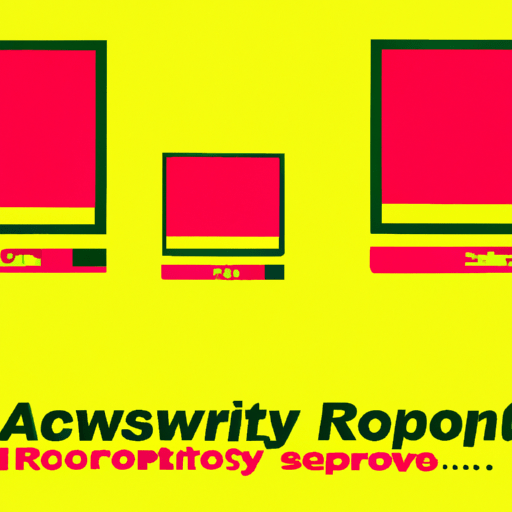
-
Table of Contents
- Responsive Logos: Adapting to Different Screen Sizes
- The Rise of Responsive Design
- The Importance of Responsive Logos
- Examples of Responsive Logos
- 1. Google
- 2. Coca-Cola
- 3. Airbnb
- Creating Effective Responsive Logos
- 1. Simplify the Design
- 2. Prioritize Scalability
- 3. Test Across Devices
- 4. Consider Typography
- Conclusion
Responsive Logos: Adapting to Different Screen Sizes

In today’s digital age, where smartphones, tablets, and various other devices dominate our lives, it is crucial for businesses to have a strong online presence. One of the key elements of a successful online presence is a well-designed and responsive website. However, many businesses overlook an equally important aspect of their online branding – their logo. A logo is the face of a brand, and it needs to adapt to different screen sizes to ensure a consistent and impactful user experience. In this article, we will explore the concept of responsive logos, their importance, and how businesses can create effective and adaptable logos for their digital platforms.
The Rise of Responsive Design
Before diving into the specifics of responsive logos, it is essential to understand the broader context of responsive design. Responsive design is an approach to web design that aims to create websites that provide an optimal viewing experience across a wide range of devices and screen sizes. With the proliferation of smartphones and tablets, it became evident that traditional fixed-width websites were not suitable for the diverse range of devices people use to access the internet.
Responsive design revolutionized the web design industry by introducing fluid grids, flexible images, and media queries. These techniques allow websites to adapt their layout and content based on the screen size and capabilities of the device being used. As a result, users can enjoy a seamless browsing experience, regardless of whether they are using a desktop computer, a smartphone, or a tablet.
The Importance of Responsive Logos
While responsive design has become the standard for creating user-friendly websites, many businesses overlook the importance of adapting their logos to different screen sizes. A logo is a visual representation of a brand’s identity, and it plays a crucial role in establishing brand recognition and recall. However, if a logo is not responsive, it can lose its impact and effectiveness on smaller screens, leading to a disjointed user experience.
Consider a scenario where a user visits a website on their desktop computer and sees a beautifully designed logo prominently displayed at the top of the page. The logo’s colors, typography, and overall design create a strong impression of the brand. However, if the same user visits the website on their smartphone and sees a shrunken version of the logo that is barely legible, the impact of the brand’s visual identity is significantly diminished.
Responsive logos ensure that a brand’s visual identity remains consistent and impactful across different devices and screen sizes. By adapting the logo’s design elements, such as size, layout, and typography, businesses can maintain a cohesive brand experience and enhance brand recognition.
Examples of Responsive Logos
Several well-known brands have embraced the concept of responsive logos and have successfully implemented them across their digital platforms. Let’s take a look at some examples:
1. Google
Google is known for its clean and minimalist logo design. However, the company takes it a step further by adapting its logo to different screen sizes. On larger screens, Google’s logo appears in its full glory, with vibrant colors and distinct letterforms. As the screen size decreases, the logo adjusts accordingly, ensuring that the logo remains legible and recognizable.
2. Coca-Cola
Coca-Cola’s iconic logo is instantly recognizable worldwide. To ensure that their logo maintains its impact across different devices, Coca-Cola has created a responsive version of their logo. On smaller screens, the logo adapts by removing unnecessary elements, such as the wave-shaped underline, while retaining the core elements that make the logo instantly identifiable.
3. Airbnb
Airbnb’s logo is a prime example of a responsive logo that adapts to different screen sizes. On larger screens, the logo appears in its full form, with the company name spelled out. As the screen size decreases, the logo transforms into a simplified version, featuring only the iconic “Bélo” symbol. This adaptation ensures that the logo remains recognizable and scalable across various devices.
Creating Effective Responsive Logos
Now that we understand the importance of responsive logos and have seen some examples, let’s explore how businesses can create effective and adaptable logos for their digital platforms:
1. Simplify the Design
When designing a logo, it is crucial to keep the design simple and uncluttered. Complex logos with intricate details may lose their impact when scaled down for smaller screens. By simplifying the design, businesses can ensure that their logo remains legible and recognizable across different devices.
2. Prioritize Scalability
Scalability is a key consideration when designing a responsive logo. The logo should be able to scale up or down without losing its visual appeal or becoming distorted. Vector-based formats, such as SVG (Scalable Vector Graphics), are ideal for creating scalable logos as they can be resized without any loss of quality.
3. Test Across Devices
Before finalizing a responsive logo, it is essential to test it across different devices and screen sizes. This testing phase allows businesses to identify any issues or inconsistencies and make necessary adjustments to ensure a seamless user experience.
4. Consider Typography
Typography plays a significant role in logo design, and it becomes even more critical in responsive logos. Choosing a font that remains legible at smaller sizes is essential to maintain the impact of the logo. Additionally, businesses should consider using responsive typography techniques, such as fluid typography, to ensure that the logo’s typography adapts to different screen sizes.
Conclusion
Responsive logos are an integral part of a brand’s online presence. They ensure that a brand’s visual identity remains consistent and impactful across different devices and screen sizes. By adapting the logo’s design elements, businesses can enhance brand recognition and provide a seamless user experience. Through examples and best practices, we have explored the importance of responsive logos and how businesses can create effective and adaptable logos for their digital platforms. By prioritizing responsive logo design, businesses can strengthen their online branding and leave a lasting impression on their target audience.
